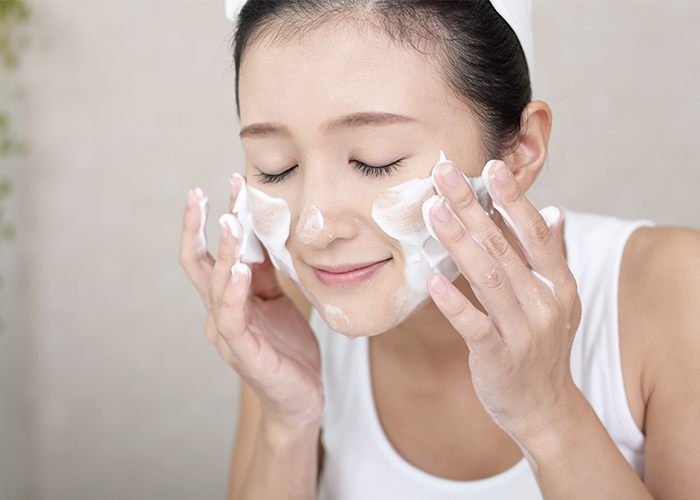If you’re one to follow beauty accounts on social media, you would have undoubtedly seen videos of people using pore vacuums to suck out the gunk from their pores.
Yup, these TikToks and Instagram clips are most definitely not for the squeamish (the same goes for pimple-popping videos), but some seem to have gone viral because of their supposed blackhead-purging abilities. These devices have left us wondering if they really are a magical cure-all for pores and if we should be getting one, pronto.
To help us determine if they’re a must-have in our routines, we called on Dr. Teo Wan Lin, accredited dermatologist and medical director of TWL Specialist Skin & Laser Centre, to help us understand what pore vacuums are and do.
Keep reading to find out if they’re able to accomplish what they claim, and if you really need one in your skincare routine.
What are pore vacuums?

Credit: Xikeo
Unlike topical skincare products that exfoliate or dissolve the sebum, dead skin, dirt, and other impurities, pore vacuums use mechanical suction to remove debris that has settled on the skin, much like its name suggests.
“When you think of pore strips, it uses an adhesive to remove this debris – pore vacuums are a similar attempt, but it applies suction,” Dr. Teo explains.
Are pore vacuums really effective?

Credit: Min An/Pexels
You may have seen an Instagram post or two showcasing the dramatic before and after results of using a pore vacuum. While these tools do use suction to extract sebum, dirt, and other debris from the skin to reveal fewer blackheads as these posts suggest, they’re not miracle devices.
“Pore vacuums are not part of conventional treatments in dermatology for blackheads or acne,” Dr. Teo clarifies. “Blackheads and whiteheads are different forms of the same condition, acne. When these are infected, you get papules, which are red and painful. If it gets even more infected, you get cysts.”
Dr. Teo also highlighted that the appearance of blackheads does not indicate dirty skin. Instead, “sebum and keratinaceous material in your pores get oxidised, which causes blackheads to form.”
“When you physically remove [blackheads] in that area, they then reaccumulate in a couple of days. The same thing with pore strips – they do nothing to stop the underlying process. Pore cleansing is perhaps something of a gimmick. It probably gives the user a temporal relief seeing that the debris has been sucked out. It’s not statistically proven to have additional benefits on top of regular cleansing,” Dr. Teo confirms.
“I don’t think they should be marketed as being effective at cleaning pores and removing blackheads, because the basic definition of skin cleansing is balancing the skin microbiome and pore cleansing does nothing,” Dr. Teo says.
Side effects of using pore vacuums
If you watched YouTube or TikTok videos of users trying out pore vacuums for the first time, you probably noticed that some of them experienced redness instantly. According to Dr. Teo, 95% of traditional pore vacuums are a little too harsh on the skin.
“I would like to caution against [using a pore vacuum] because it actually applies excessive pressure on your skin,” Dr. Teo warns. “I’m talking about traditional pore vacuums and not microdermabrasion tools that also utilise vacuum suction in combination with the inert crystals on the microdermabrasion head that’s meant to renew and exfoliate the skin.”
“It’s common for individuals to get increased redness, sensitivity, and in rare cases, bruising,” she shares. In other words, cranking the vacuum up to the highest setting won’t necessarily extract more blackheads, but it may just leave you with a fresh hickey.
If you have eczema or sensitive skin, you may find that it exacerbates your skin’s condition. “If you have inflamed acne, if you’re on isotretinoin, or if you’re on treatment, then that’s a no-no as well because it’s going to increase sensitivity. Pretty much any diagnosed medical condition of the skin would react adversely to pore vacuums,” Dr. Teo explains.
What happens when you use it on pimples and blemishes?
“If you have cystic acne, which is the more severe form of acne, using a pore vacuum on these lesions would be a very bad idea and may introduce more infection,” Dr. Teo warns.
Instead, opt for skincare products that are infused with anti-inflammatory botanical ingredients. “We use chorella vulgaris, which is an algae extract that directly targets sebum production as well as inflammation. And Berberine, a herb that’s quite well-known in Eastern medicine but has recently been shown in dermatology literature to help kill the bacteria that causes acne,” she shares.
@tyler.oliveirai bought a “pimple vacuum” off the internet and THIS happened… #acne#pimple#pimples♬ original sound – Tyler Oliveira 👑
In the case of the TikToker who used a pore vacuum on an inflamed pimple (above), Dr. Teo says, “He should instead be applying the pimple cream and then he can use a hydrocolloid patch to absorb all the pus naturally and allows a moist healing environment rather than damaging the skin further and provoking the inflammation.”
Alternatives to banishing blackheads

In place of an at-home pore vacuum, Dr. Teo recommends a simple skincare regimen that involves retinoids and double-cleansing to combat blackheads and pore buildup.
“If you really struggle with congestion and blackheads, you might have a case of moderate or persistent type of acne, and it must be treated medically at least with a topical retinoid,” she advises. “You can try over-the-counter acne creams that contain botanical actives. Hydrocolloid patches are also helpful to reduce acute swelling.”
Related reads:


